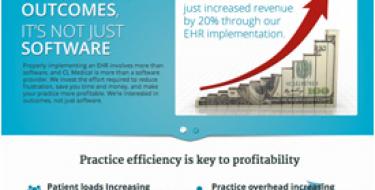Disruption Roadmap: A Path Toward Creating More Value, Achieving Monopolistic Advantage, and Changing Your Industry
Over the years I have worked with companies all over the spectrum of digital competency, and through that experience have identified four Tiers of Disruption that serve as a roadmap, or as a framework for setting goals and for providing context around discussions whose aim is to usher in marketing innovation. At Digett, we are generally focused on digital as it applies to marketing. But as companies adopt and adapt digital marketing strategies and initiatives, they invariably come to understand that marketing, eventually, permeates all aspects of the organization. A simple example of this is how well-articulated positioning and thought leadership on a well-designed and maintained website—something we typically think of as impacting the decisions of prospects and customers—has a positive impact on recruiting talent.
The Tiers of Disruption are not necessarily entirely contiguous. That is, it's quite possible that Tiers 1 through 3 could be skipped entirely while an organization fully embraces and masters Tier 4. But such are the exceptions, and these generally occur in the context of startups, some of which are spun off by firms that have embraced digital at all Tiers but find the weight of a legacy culture too heavy to give proper attention to such disruptive initiatives. In our experience, starting with low-hanging fruit leads to short-term gains which fuel further energy and curiosity within the organization. These are cultural turning points that can be cultivated to lead an organization through an exciting digital evolution.
Tier 1: Harvest low-hanging fruit.
Your company may have already scaled Tier 1, but surprisingly many professional services firms have not addressed the most foundational elements of digital marketing; namely, a basic digital marketing plan to attract prospects. While one would be hard-pressed to find established firms without so much as a website, even so-called "sophisticated" firms often have little in the way of strategy to guide what the website says and how it is used.
This is not good news for "business as usual" leaders, when research indicates that as leadership turnover occurs within a firm's prospects and clients, those assuming responsibility have a greater reliance on the web and digital technology in performing their jobs. B2B buyers, in particular, spend greater time researching service providers using LinkedIn and company websites. At best, as far as the digital laggers are concerned, human dialog between buyer and seller often begins only after deep biases have already been established through a buyer's online research. At worst, deals are lost when frustrated or impatient buyers make decisions to omit possible suitors whose digital presence does little to help them educate themselves.
To address this emerging reality in buyer behavior, companies should be taking action on a number of fronts to turn these behaviors into an advantage. Typical approaches might include:
- Revisit firms positioning, messaging and overall marketing strategy to ensure everyone's on the same page and that the message is being communicated in the right places.
- Develop buyer personas to serve as guideposts for developing insight-driven content and syndicating through the most appropriate channels.
- Deploy scalable digital infrastructure incorporating basic automation and lead management tools.
- Develop, deploy and promote quality content across a manageable selection of channels. Empower and incent employees to support this effort.
- Gather important behavioral data and track useful KPIs.
It may seem overwhelming to leaders charged with guiding their firms onto the digital path, especially when the prevailing company culture offers little to support such change. But with the right help such change can take place more quickly than one might think. This is low-hanging fruit. Not only does it make for relatively easy picking, the rewards of the harvest can energize stakeholders to look beyond Tier 1 activities for even greater rewards ahead.
Tier 2: Refine (strategy and tactics). Broaden (nurturing to include the complete customer lifecycle).
Firms who have fully embraced Tier 1 have reason to feel good. Not only have they already likely differentiated themselves from their competition, they have seen the impact that flexing their digital muscles can have on their brand and their bottom line. Impressive as these gains may seem, however, they won't hold up long in an industry that will change as much as professional services. As Steven Pressfield describes in his best-selling War of Art, satisfaction leads to stagnation. Instead of pausing to bask in victory, Tier 1 firms are better off building on that success, harnessing any momentum gained thus far to further cement their position as a market leader through digital discipleship. How, you ask? Here are a few ideas:
- Incorporate any new knowledge of your customers into your buyer personas on an ongoing basis.
- Identify the top-performing content (remember the KPIs from Tier 1?) and figure out how to replicate that success.
- Re-allocate efforts toward highest ROI activities; drop the low-performing tactics.
- Think outside the box to identify and experiment with other channels and tactics.
- Address the questions that prospects ask before they say "yes" with case studies, comparisons.
- Revisit/refine KPIs and data collection efforts. Envision new ways to use existing data, and what other data could lead to useful insights.
- Develop meaningful nurturing tracks, not just for prospects, that engender loyalty and facilitate the kind of communication that leads to Tier 3.
- Sign a contract with (or "team up with") Sales that precisely defines the characteristics of a quality sales lead and which commits Marketing to attracting, nurturing, and handing off a minimum number of such quality leads on a recurring basis.
Tier 3: Use customer dialog to power service innovation.
In Tier 3, teams comprised of representatives of sales, marketing, delivery, and support functions collaborate to improve any or all aspects of a firm's services.
- Deepen focus on capturing customer feedback in the form of actionable data to better understand customer perception of value and shortcomings.
- Incorporate feedback into operations and service models through purposeful and structured process.
Meaningful dialog with clients can help firms establish monopolistic advantage, where competition cannot meaningfully replicate their service or their clients' experience.
Tier 4: Disrupt your industry through new services and business models.
Ahhhhh, the holy grail. Think Google. Or, more recently, Uber and Lyft. Soothe.com is another example, upending the market for personal massages, building a massive network of skilled masseuses accessible anytime, anywhere through a mobile app.
What these businesses exemplify is that the digital economy is about more than increased reliance on digital channels for communication. It's about entirely new delivery models, empowering humans to serve themselves, and leveraging data that never before existed to better serve customers.
There may be as many ways to uncover industry-changing innovation as there are pixels on the latest Macbook Pro Retina screen, and this goes well beyond the scope of this article. But tune in to future pieces to carry on a conversation about experimentation with new methods of delivery, new ways to charge for services, new licensing models, and more.
MONTHLY MARKETING INSIGHTS.
Get thought-provoking and actionable insights to improve how your firm makes a connection with your customers.






LEAVE A COMMENT